Before talking about “proven components” and “proven safety principles”, according to the requirements of the standard, we know that the actuator applied in the safety loop, such as intermediate relays, contactors, etc., and the contacts used as monitoring functions must meet the “forced guidance logic”, today we will talk about the relevant content of forced guidance logic.
What is forced oriented logic?
According to the definition in Appendix L of IEC 60947-5-1, a mechanical contact is a combination of normally open contacts and normally closed contacts (components) designed in accordance with the following requirements, that is, they cannot be 
Why do we need to use relays and contactors that force guide contacts instead of regular components? Many customers often ask about the difference between these two types of products. In fact, they differ only in whether the NO and NC contacts can be closed at the same time.
In the safety loop, we generally use NC contacts to access the feedback loop (feedback loop) to judge whether NO contacts effectively cut off the dangerous loop. In other words, if the safety controller cuts off the relay coil, the NC contact of the ordinary relay will close with the armature controlled by the coil; If we choose a forced guide relay/contactor, in the case of NO contact fusion welding, due to the characteristics of NO and NC can not be closed at the same time, the NC contact will be in the disconnected state, which can correctly reflect the fault in the loop.
 中文版
中文版




